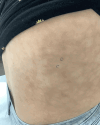Painful, Tender, Localized, Idiopathic Livedo Reticularis
- PMID: 38357060
- PMCID: PMC10866324
- DOI: 10.7759/cureus.52311
Painful, Tender, Localized, Idiopathic Livedo Reticularis
Abstract
Livedo reticularis (LR) is a unique cutaneous condition characterized by a reddish-blue to purple, net-like cyanosis of the skin, often associated with disturbances in cutaneous blood flow. This case report discusses a 30-year-old woman with a history of Hashimoto thyroiditis, vitamin D deficiency, migraines, and goiter who presents with painful, localized LR on her right flank. Despite her extensive medical history, there were no significant findings in her laboratory and imaging studies, including a normal epidermis in skin biopsies. The LR in this case is distinguished by its persistence and the presence of pain, a symptom not commonly associated with LR. Various treatments, including 5% lidocaine ointment, oral analgesics, and gabapentin, were considered, but her symptoms remained stable over 13 months. This case exemplifies the complexity of LR, particularly when presenting with atypical symptoms like pain. It highlights the need for further research into the pathophysiology and treatment of LR, especially in cases deviating from the typical symptomatology, and suggests the potential value of a multi-disciplinary approach to management.
Keywords: biopsy; idiopathic; livedo reticularis; skin; tender.
Copyright © 2024, Algarin et al.
Conflict of interest statement
The authors have declared that no competing interests exist.
Figures
Similar articles
-
Livedo reticularis: A review of the literature.Indian Dermatol Online J. 2015 Sep-Oct;6(5):315-21. doi: 10.4103/2229-5178.164493. Indian Dermatol Online J. 2015. PMID: 26500860 Free PMC article. Review.
-
Generalized Livedo Reticularis: A Rare Variety.Indian J Dermatol. 2019 Jan-Feb;64(1):59-61. doi: 10.4103/ijd.IJD_246_18. Indian J Dermatol. 2019. PMID: 30745637 Free PMC article.
-
Livedo reticularis.Dermatol Online J. 2013 Dec 16;19(12):20705. Dermatol Online J. 2013. PMID: 24364996
-
A Case of Painful Hashimoto Thyroiditis that Mimicked Subacute Thyroiditis.Chonnam Med J. 2012 Apr;48(1):69-72. doi: 10.4068/cmj.2012.48.1.69. Epub 2012 Apr 26. Chonnam Med J. 2012. PMID: 22570820 Free PMC article.
-
[Livedo reticularis, cerebrovascular disorders and mitral disease: a new cause of Sneddon's syndrome?].Ann Dermatol Venereol. 1990;117(12):925-30. Ann Dermatol Venereol. 1990. PMID: 2082786 Review. French.
References
-
- Livedo reticularis. A review. Champion RH. Br J Dermatol. 1965;77:167–179. - PubMed
-
- Livedo reticularis: an enigma. Sangle SR, D'Cruz DP. https://pubmed.ncbi.nlm.nih.gov/26223086/#:~:text=Livedo%20reticularis%2... Isr Med Assoc J. 2015;17:104–107. - PubMed
-
- Livedo racemosa generalisata: An evaluation of thirty-four cases. Lubach D, Schwabe C, Weissenborn K, Hartung K, Creutzig A, Drenk F. J Am Acad Dermatol. 1990;22:633–639. - PubMed
-
- The spectrum of differential diagnosis in neurological patients with livedo reticularis and livedo racemosa. A literature review. Kraemer M, Linden D, Berlit P. J Neurol. 2005;252:1155–1166. - PubMed
Publication types
LinkOut - more resources
Full Text Sources


